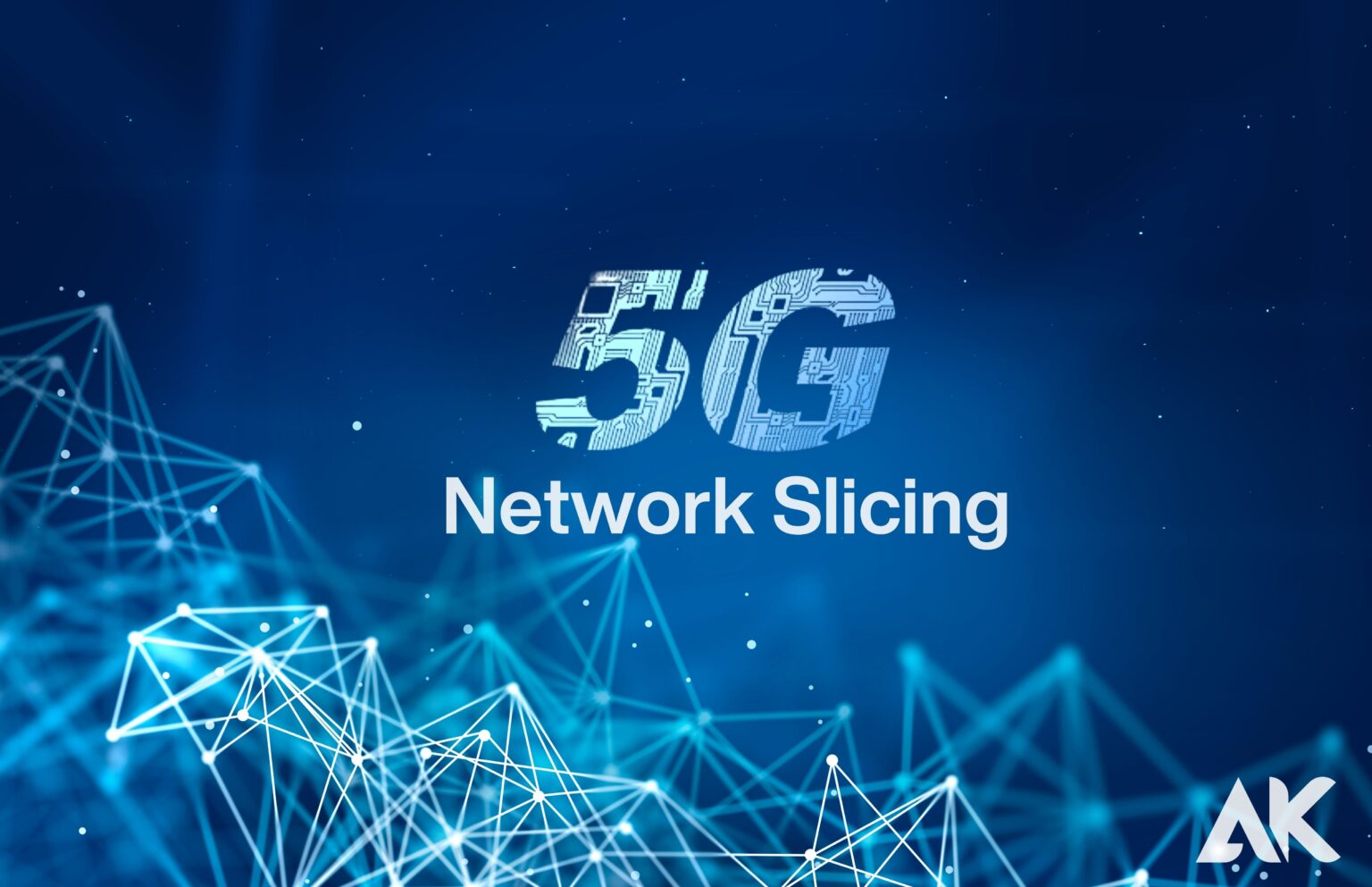A shared network domain, or a collection of shared network and computing resources, is layered with several virtual networks via a technique called network slicing. Because 5G requires network slicing as a basic capability, while 4G and previous generations of cellular data services did not and could not support it, network slicing is most frequently discussed with 5G networks.
Within the constraints imposed by the underlying physical networks, each slice of a network is free to have its logical architecture, security policies, and performance characteristics. It is possible to designate separate slices for distinct uses, such as isolating traffic for particular users or device classes or guaranteeing that a particular application or service receives priority access to capacity and delivery. The network operator can maximize the utilization of network resources and service flexibility by slicing the network.
What is 5G network slicing?

Using distinct “slices” of the same spectrum band, network slicing is a sort of capability that allows numerous independent networks to exist on the same physical network. This enables businesses to support various application needs on the same network in terms of security, dependability, and performance.
Network slicing divides the network and its resources rapidly to serve different applications, devices, domains, and groups. It does this by utilizing automation, Software-Defined Networking (SDN), and Network Function Virtualization (NFV). Businesses may satisfy Service Level Agreements (SLAs) and guarantee that every application always has the resources it needs at a reasonable cost by implementing network slicing.
Why 5G network slicing matters

Network slicing gives companies greater, more precise control over traffic resources in the context of cellular networks. Every traffic slice may have different latency, quality of service (QoS), resource, and security configuration needs. A network slice used to monitor an Internet of Things (IoT) lighting system, for instance, might have different features than one enabling streaming video in high definition.
In non-sliced networks, devices have access to more resources than they need. A simple text message delivered through an app on a worker’s phone, for instance, wouldn’t need 100 Mbps. Network slicing preserves resources by understanding the context and use case of each application and allocating the appropriate amount of resources. Network slicing across 5G networks is now easier to achieve because of NFV and other new core network technologies. There are benefits to network slicing for managed service providers, mobile network operators, and businesses.
How Network Slicing Works
Several networks, or slices, are created on top of a single shared network through the use of virtualization technologies in network slicing. Every slice has distinct features related to bandwidth, security, throughput, and latency. This segmentation is made possible by software-defined networking, which divides the network control plane from the data plane responsible for processing packets. On the data plane, the control plane defines packet handling rules that are used to establish virtual networks.
Put simply, this may be considered a more advanced kind of virtual local area network (VLAN) specifically designed for 5G networks. Radio Access Networks (RANs), often referred to as Software-Defined RANs (SD-RANs), are subject to the same virtualization. Network operators can physically divide traffic on many radio networks, distribute pooled resources, and, if necessary, combine the resources of numerous networks by using network slicing over an SD-RAN.
With the help of these choices, service providers and private businesses may increase resource utilization and spectrum efficiency much beyond what was possible with earlier cellular generations.
Network Slicing vs MicroSlicing
Conventional network slicing was created to divide resources among vast, expansive radio networks for mobile network operators. Businesses may greatly benefit from this technology, but because of its complexity and lack of customized controls, it has stayed out of reach for large organizations.
Thanks to MicroSlicing technology, organizations may now allocate the performance and dependability required for a given application by making the greatest use of the range of resources at their disposal. With microslicing, corporate performance and dependability are combined with very granular QoS settings specifically designed for wireless networks’ flexibility and mobility. MicroSlicing transcends conventional network slicing by enabling organizations to manage their resources by application or device across both the WAN and core network by building on top of current standards.
MicroSlicing facilitates the effortless deployment of freshly specified SLAs from your private cellular network to your current network by integrating with your current IT architecture and security regulations. This implies that companies don’t have to create new regulations and application processes from the beginning. MicroSlicing is automatically deployed to new devices by policy automation, which allocates flows according to the kind of device, group, or application that is identified. A freshly installed security camera, for instance, may be instantly detected by MicroSlicing and assigned to the current video surveillance slice.
Artificial intelligence and machine learning are utilized to track each slice’s performance and comprehend how the app behaves over time. AI can analyze app performance benchmarks across different networks and recommend adjustments across the slice to improve performance, thanks to this KPI-level observability. Businesses can fine-tune their slices to reach their targeted baseline performance through this cycle of continual improvement.
Benefits of network slicing
The secret to “just right” services for service providers is using virtual network functions in conjunction with slicing. Specifically, service providers only supply the capacity needed for specialized services to satisfy the demands of paying consumers, based on general-purpose wireless infrastructure and general-purpose computing and storage resources. Even complicated and unique client environments may be quickly spun up by utilizing all virtual service platforms and the built-in capacity-slicing capabilities.
For service providers, the following advantages come from being able to customize at a cheap cost:
- Reduce the obstacles to experimenting with new service offerings to generate new revenue streams. Specialized hardware does not need to be purchased and then completely depreciated when it is created for a task.
- Since they don’t require specialist technology, many types of services may be given simultaneously, increasing flexibility.
- Because the physical infrastructure is completely generic, scalability is more easily achievable.
- Since the capacity to continuously test new things allows for the best possible use of resources, an increased return on investment is also expected.
Network slicing use cases
Use cases centered on security, capacity, and performance are supported by network slicing. Emerging Internet of Things business models are involved in many application cases. The following are a few use cases for network slicing:
- instantaneous performance. To assure responsive control, a corporation reliant on a 5G network for autonomous vehicle management may have to contract for a mobile network slice with latencies less than 5 ms and strict assurances of packet delivery at the minimum throughput needed. To ensure the slice on the lowest-latency hardware and pathways between cars and cloud or edge resources, the provider would leverage URLLC capability. They would also reserve enough capacity to fulfill the throughput objective.
- Ability. Latency might not be an issue for a huge auditorium’s security monitoring system. Nonetheless, the security firm could choose to purchase assured camera data transmission. Stated differently, the organization’s goal would be for each camera to receive 1.5 megabits per second of throughput for its traffic with never a packet loss. To suit the demands of this slice, the provider may combine various connectivity and processing device choices.
- Protection. A hospital may wish to segregate all traffic to and from pacemakers for a human health monitoring system in a metropolitan region. This would require a slice with single-user virtual resources to reduce the possibility of a customer data leak and the threat of the control channel being compromised.
Commercial and industrial possibilities
The popularity of SD-WAN and network segmentation technology is because both larger companies and smaller ones find slicing to be a desirable choice for managing their networks’ performance and security. Slicing makes a wireless WAN (WWAN) and a corporate wireless LAN (WLAN) more useful as 5G networks develop and expand.
- WAN. Small branch offices relied on 4G Long-Term Evolution (LTE) before 5G as a fallback connection if their principal wired connections failed. They also occasionally used LTE as their primary connection. With its faster speeds and slicing, 5G will hasten the WWAN model’s adoption and boost its use as main or exclusive connectivity, as it will provide businesses with real service-level agreements that accurately represent the carriers’ capacity and performance control.
- WIFI. The same increased controllability features will make 5G a more attractive option to replace private Wi-Fi-based WLANs. Traditionally, businesses use mobile and remote network access technologies together with setting up and maintaining a private network. Many will instead utilize 5G exclusively with slicing and 5G. Mobile broad bare regardless vote network slice connected into the corporate WAN allows users to enjoy the same experience companies of where they are.
Conclusion
Network slicing is a fundamental capability in 5G networks, allowing multiple independent networks to exist on the same physical network using different “slices” of the same spectrum band. This enables organizations to accommodate different application requirements for security, reliability, and performance on the same network. Network slicing divides the network and its resources rapidly to serve different applications, devices, domains, and groups. It does this by utilizing automation, Software-Defined Networking (SDN), and Network Function Virtualization (NFV).
FAQS
Why is network slicing important in 5G?
Given that a single network may be split up to accommodate many use cases according to consumer demand and segmentation, the advantages of network slicing are obvious. To achieve the speed, throughput, and latency required to span the breadth of network slicing in 5G, operators can distribute resources to each slice separately.
Why is network slicing important?
Benefits of slicing networks
Through the effective use and control of network resources, network slicing enables operators to maximize return on investment and offer distinctive services at scale.
What is 5G, and why does it matter?
Higher multi-Gbps peak data rates, extremely low latency, greater dependability, enormous network capacity, enhanced availability, and a more consistent user experience are all intended benefits of 5G wireless technology.

